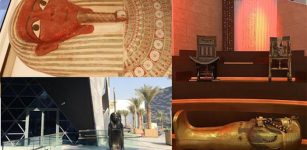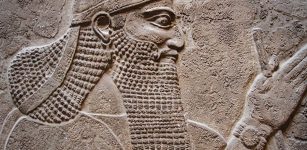What Was Humor Like In The 13th Century?
AncientPages.com - People love to laugh. They always have and humor has been a part of our history as long as humanity has existed. Historical records show that our ancestors appreciated to laugh just as much as we do today.
What many consider to be the world’s oldest joke is written in a medieval manuscript kept in the British Library. The language of the joke indicates that it was written about a thousand years ago. The text is written in Old Irish. You can read the world’s oldest joke here and see if it makes you laugh.
Historical studies of Icelandic Sagas reveal Vikings had dark humor and joked even during deadly battles.
It was a mixture of sarcasm, irony and unusual jokes. The Vikings approach was that, if you knew you were going to die, why not do it laughing.
We can also wonder - what was humor like in the 13th century?
We tend to think of the Middle Ages as grotesque and dreary.
However, 13th century elites made use of laughter quite deliberately – and it resounded most loudly when it was at someone else’s expense.
The things that medieval elites considered amusing can act as a window on their interpersonal relations: humour created a form of group solidarity and a clear distinction between friends and foes, thus revealing the power and value of entertainment, according to Beate Albrigtsen Pedersen at the Department of Archaeology, Conservation and History at the University of Oslo.
Pedersen seeks to explore what entertainment and comedy meant to Norwegian and Icelandic society and politics in the 13th century.
Humor has always been a part of our lives, and we have always had the ability to laugh at things, but there has been little research into the role of humor in medieval Norse society and how the forms of humor changed over time.

Is the world's oldest joke written on this 1,000-year-old ancient medieval manuscript? Image credit: British Library
The historian believes that knowledge about the jesting and spite favoured by the aristocracy can help us better understand the society and people of the 13th century.
"Humour is often regarded as a flippant research topic, but the ability to be amused and laugh is an important part of life and may thus provide us with an alternative perspective on the Middle Ages.
Our relationship to the saga literature is steeped in national romanticism, and I believe that reading it as entertainment literature will bring out new aspects.
The sagas were also intended to amuse people," she says.
No self-irony
The aristocrats knew well how to have a good time, according to Pedersen.
The elite used humour very deliberately – most often to ridicule others. Humour established a form of group affiliation and a clearer distinction between friends and foes.
See also:
Vikings Had Dark Humor And Joked Even During Deadly Battles
10 Most Bizarre Forms Of Ancient Taxes: Surprising And Funny
Is This The World’s Oldest Joke?
Bes – Ancient Egyptian Dwarf God Of Childbirth, Humor, Song and Dance
Sarcastic comments and put-downs are elements of our contemporary humour as well, but the essential matter is how it was perceived. Self-irony is a key element in Pedersen’s analysis of medieval humour, or more precisely: the absence of self-irony. With no redeeming self-irony, this form of humour was often used to defeat political opponents, or to assert oneself and shame others.
Modern humour is largely based on self-irony, permitting us to laugh at ourselves and others, without any repercussions.
Clearer norms of laughter
New courtly ideals were introduced in the late 13th century as the old society of rival chieftains was replaced by the ideal of the king as the sole ruler, chosen by God. Pedersen is studying what happened to humour during this transition and how the elite culture changed.
As the 13th century draws to an end, we can see clearer norms for what were permitted as objects of ridicule.
Vikings had dark humor and joked even during deadly battles.
The courtly ideals forced the elite to behave with more decorum, resulting in less ribaldry. At the same time, we can see that self-irony is becoming more common as the 14th century approaches.
Sarcastic comments by members of the elite no longer entailed the same grave consequences. They took the ridicule differently – by holding their heads high.
Written by and for a social elite
The humor researcher has reviewed a series of sagas, with sources ranging from the sagas of Icelanders and tales of kings and knights to ideological writings.
"I search for humorous features that recur in the sagas, such as ordinary jokes, insults, imagery and metaphors that evoke laughter in different scenes. If I come across similar situations, although laughter is not mentioned explicitly, I may assume that they were intended to be humorous as well," Pedersen says.
Pedersen uses the term humor, although this concept did not exist in medieval times.
"My research refers to our concept of humour. Humour remains a difficult concept to define. I study the things that they found comical, both what was intentionally comical and what was perceived as such, by the numerous characters in the sagas as well as by potential listeners in the 13th century," Pedersen explains.
Admittedly, all sources are concentrated at the upper echelons of society.
The sagas were written by and for an elite, so it’s difficult to draw any conclusions about the common people. Politics and everyday life went hand in hand for the aristocracy. It is essential to bear in mind that it is the sources’ portrayal of life – and how they wanted to describe the past and future – that emerges, Pedersen explains.
Kicking the little guy
In politics, humour was used to add fuel to rivalry and create conflicts – by laughing or remaining silent, the aristocrats took sides in the conflict.
"A prime example is in the story of the wedding at Reikholt in the early 12th century in Þorgils saga ok Hafliða, when a great feast was held," Pedersen says.
Black humor
Black humor also had a natural place in medieval life.
"The typical form this takes is a final punchline before someone dies. A concrete example is provided by Njáls Saga, in which there is a description of a swordfight that ends when one of the fighters cuts off the other man’s leg. Kol, the man with the severed leg, looks in alarm at the stump, and his adversary remarks: ‘There’s no need to look, it’s just like it seems, the leg is off.’ We may regard such final quotes as a dry form of humor, and I believe they were meant to be so at the time of writing as well," Pedersen explains.
Copyright © AncientPages.com All rights reserved. This material may not be published, broadcast, rewritten or redistributed in whole or part without the express written permission of AncientPages.com
More From Ancient Pages
-
 Amulets, Figurines Discovered In Recently Unearthed Limestone Sarcophagus In Minya, Egypt
Archaeology | Oct 15, 2020
Amulets, Figurines Discovered In Recently Unearthed Limestone Sarcophagus In Minya, Egypt
Archaeology | Oct 15, 2020 -
 How And When Did Ancient People Start Using Oil?
Ancient History Facts | Jun 28, 2018
How And When Did Ancient People Start Using Oil?
Ancient History Facts | Jun 28, 2018 -
 Bezvodovka: Little Known Ancient Solar Observatory In Ukraine Reveals Its Secrets
Archaeoastronomy | Jan 4, 2017
Bezvodovka: Little Known Ancient Solar Observatory In Ukraine Reveals Its Secrets
Archaeoastronomy | Jan 4, 2017 -
 Early European Farmers Traced To Anatolia, DNA Study Shows
Archaeology | Jan 5, 2016
Early European Farmers Traced To Anatolia, DNA Study Shows
Archaeology | Jan 5, 2016 -
 Were The Viking Berserkers True Or Drug Addicted Warriors Fighting In Trance?
Featured Stories | Feb 3, 2015
Were The Viking Berserkers True Or Drug Addicted Warriors Fighting In Trance?
Featured Stories | Feb 3, 2015 -
 Karakorum – Genghis Khan’s Headquarters And Important City In History Of Silk Road
Civilizations | Mar 26, 2016
Karakorum – Genghis Khan’s Headquarters And Important City In History Of Silk Road
Civilizations | Mar 26, 2016 -
 Remarkable Ancient Animal Engravings Discovered In Unknown Cave In Sinai
Archaeology | May 1, 2020
Remarkable Ancient Animal Engravings Discovered In Unknown Cave In Sinai
Archaeology | May 1, 2020 -
 On This Day In History: ‘Principia Mathematica’ Monumental Work Published By Isaac Newton – On July 5, 1687
News | Jul 5, 2016
On This Day In History: ‘Principia Mathematica’ Monumental Work Published By Isaac Newton – On July 5, 1687
News | Jul 5, 2016 -
 Mictlan – Underworld Realm Of The Dead In Ancient Aztec Beliefs
Aztec Mythology | Jul 2, 2018
Mictlan – Underworld Realm Of The Dead In Ancient Aztec Beliefs
Aztec Mythology | Jul 2, 2018 -
 Ancient Coffin Of Priest Psamtik, Son Of Osiris And Five Replicas Of Goddess Maat Sent On Upcoming Expo
Archaeology | Oct 5, 2021
Ancient Coffin Of Priest Psamtik, Son Of Osiris And Five Replicas Of Goddess Maat Sent On Upcoming Expo
Archaeology | Oct 5, 2021 -
 Unexpected Discovery Of 600 B.C Assyrian Palace In Shrine Destroyed By Isil Militants
Archaeology | Mar 2, 2017
Unexpected Discovery Of 600 B.C Assyrian Palace In Shrine Destroyed By Isil Militants
Archaeology | Mar 2, 2017 -
 Hawass Says Claims That The Ancient Egyptian Civilization Was Black Are Lies
Civilizations | Jun 21, 2024
Hawass Says Claims That The Ancient Egyptian Civilization Was Black Are Lies
Civilizations | Jun 21, 2024 -
 Legendary Grianán Of Aileach Built By God Dagda Of Tuatha De Danann Was Once The Royal Seat Of The Kingdom Of Ailech
Featured Stories | May 13, 2021
Legendary Grianán Of Aileach Built By God Dagda Of Tuatha De Danann Was Once The Royal Seat Of The Kingdom Of Ailech
Featured Stories | May 13, 2021 -
 Archaeological Discoveries At Fort San Juan Reveal Hidden History Of Conquistadors In American South
Archaeology | Mar 12, 2018
Archaeological Discoveries At Fort San Juan Reveal Hidden History Of Conquistadors In American South
Archaeology | Mar 12, 2018 -
 1,700-Year-Old Roman Bust Excavated In Ancient City Of Soli Pompeiopolis In Turkey
Archaeology | Jul 19, 2018
1,700-Year-Old Roman Bust Excavated In Ancient City Of Soli Pompeiopolis In Turkey
Archaeology | Jul 19, 2018 -
 On This Day In History: Berlin Opened For One Day – On Dec 20, 1963
News | Dec 20, 2016
On This Day In History: Berlin Opened For One Day – On Dec 20, 1963
News | Dec 20, 2016 -
 Thousands Of Roman Coins Found Across Europe Are Fake – Archaeologists Say
Archaeology | Jul 9, 2019
Thousands Of Roman Coins Found Across Europe Are Fake – Archaeologists Say
Archaeology | Jul 9, 2019 -
 What Was Asphalt Doing On A 9,000-Year-Old Skull Discovered In The Judean Desert
Archaeology | Feb 1, 2022
What Was Asphalt Doing On A 9,000-Year-Old Skull Discovered In The Judean Desert
Archaeology | Feb 1, 2022 -
 Evidence Of A Lost Advanced Ancient Civilization In Cincinnati – Remarkable Artifacts And Ancient Bodies That Shouldn’t Exist
Ancient Mysteries | May 8, 2018
Evidence Of A Lost Advanced Ancient Civilization In Cincinnati – Remarkable Artifacts And Ancient Bodies That Shouldn’t Exist
Ancient Mysteries | May 8, 2018 -
 Ancient Roman Statues of Goddess Venus And Other Precious Artifacts Found In A Trash Pit In France
Archaeology | Apr 8, 2023
Ancient Roman Statues of Goddess Venus And Other Precious Artifacts Found In A Trash Pit In France
Archaeology | Apr 8, 2023



